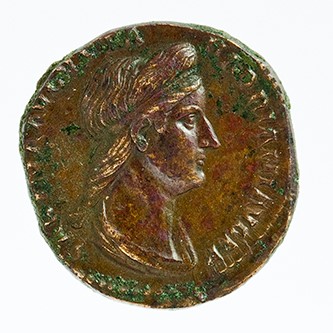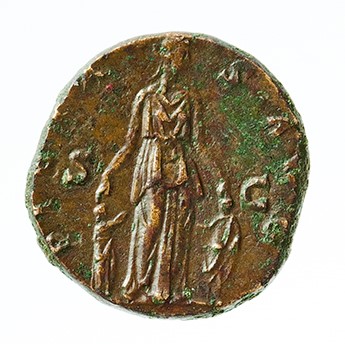Acquisition number: 1969.02
Obv.: Bust of Sabina r., draped, diademed; hair fastened on long swirl at back of neck, drawn up high at front. SABINA AVGVSTA HADRIANI AVG(usti) P(atris) P(atriae).
Rev.: Pietas standing front, head right, draped, holding hands over two children (girl at left, boy at right). PIETAS AVG(usta?). In field, S(enatus) C(onsulto).
Title: Dupondius of Sabina, reign of Hadrian - 1969.02
Acquisition number: 1969.02
Author or editor: Beryl Rawson
Culture or period: Roman Imperial
Date: AD 136
Material: Metal - Brass
Object type: Coins - Roman
Dimensions: 24mm (w)
Origin region or location: Italy
Origin city: Rome
Display case or on loan: 7
Keywords: Coin, dupondius, Roman, Imperial, Sabina, Hadrian, Pietas
Sear, D.R., Roman Coins and their Values 5 vols (London, Spink, 2000-2014) 3936; Mattingly, H.,Coins of the Roman Empire in the British Museum, 6 vols (London, 1965) 1876, pl. 98.16 (for reverse).
1969.02
Dupondius of Sabina, reign of Hadrian
10.573 g. AD 136
Obv.: Bust of Sabina r., draped, diademed; hair fastened on long swirl at back of neck, drawn up high at front. SABINA AVGVSTA HADRIANI AVG(usti) P(atris) P(atriae).
Rev.: Pietas standing front, head right, draped, holding hands over two children (girl at left, boy at right). PIETAS AVG(usta?). In field, S(enatus) C(onsulto).
Sabina was Hadrian’s wife (and Trajan’s grand-niece). She probably did not receive the title ‘Augusta’ before AD 128, when Hadrian received the title pater patriae (father of his country). Sabina died before Hadrian (AD 137) and was later deified. It is not known whether Hadrian had deified her before he died in AD 138, or whether their adoptive son Antoninus Pius did this.
Women of the imperial family in the second century were commonly associated with virtues such as Pietas (dutiful respect) here. (It is not certain whether ‘AVG’ here stands for ‘Augusta’, thus ‘Augustan dutifulness’, which could apply to both Hadrian and Sabina; or for ‘Augusti’, thus 'dutifulness of Augustus', applying to Hadrian.) These personifications were often associated with programs to encourage child-bearing and family life. Hadrian was responsible for many policies to assist families, including the continuation of Trajan’s alimenta (grain supply) program. This reverse type is similar to one issued under Trajan for Matidia, Sabina’s mother, which was itself a development of one of Trajan’s alimenta types. Sabina’s coins are not common, and this reverse type is rare. For Sabina’s two characteristic hairstyles cf. Breglia pll. XXVI and XXVII.
Sear, D.R., Roman Coins and their Values 5 vols (London, Spink, 2000-2014) 3936; Mattingly, H.,Coins of the Roman Empire in the British Museum, 6 vols (London, 1965) 1876, pl. 98.16 (for reverse).

